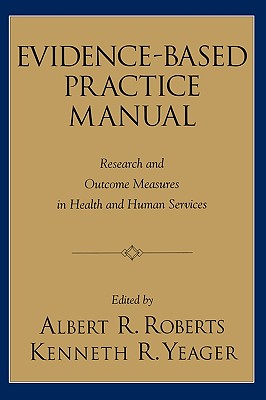图书简介
The Evidence-Based Practice Manual was developed as an all-inclusive and comprehensive practical desktop resource. It includes 104 original chapters, each specially written by the most prominent and experienced medical, public health, psychology, social work, criminal justice, and public policy practitioners, researchers, and professors in the United States and Canada. This book is specifically designed with practitioners in mind, providing at-a-glance overviews and direct application chapters. This is the only interdisciplinary volume available for locating and applying evidence-based assessment measures, treatment plans, and interventions. Particular attention has been given to providing practice guidelines and exemplars of evidence-based practice and practice-based research.
Section I: Overview and critical issues; 1: Roberts & Yeager: Systematic reviews of evidence-based studies and practice-based research: how to search for, develop, and use them; 2: Vandiver & Corcoran: Implementing best practice and expert consensus procedures; 3: Rosenthal: Overview of evidence based practices; 4: Hayward: Informing health choices: reflections on knowledge integration strategies for electronic health records; 5: Teague & Bell: Toward common performance indicators and measures for accountability in behavioural health care; 6: Casey & Krueger: An overview of focus group interviewing; 7: Yeager & Roberts: Mental illness, substance dependence and suicidality: secondary data analysis; 8: Reamer: Making participant observation research matter: a typology based on 12,000 felons; 9: Petrucci, Kirk & Reid: Computer technology and social work; 10: Chaiklin: Problem formulation, conceptualization, and theory development; 11: Almgren: Statistics for human service workers; Section II: Research ethics and step-by-step research grant guidelines; 12: Hwang, Martin & Bayoumi: Methodological, practical and ethical challenges to inner-city health research; 13: Antle, Regehr & Mishna: Qualitative research ethics: thriving within tensions; 14: Streiner: The fine art of grantsmanship; 15: Mowbray: Applying for research grants: step-by-step guidelines; 16: Crusto & Wandersman: Setting the stage for accountability and program evaluation in community-based grant-making; 17: Camasso, Harvey & Jagannathan: Conducting cost-benefit analysis in human service settings; Section III: Evidence-based practice: diagnosis, interventions, and outcome research; 18: Rosen & Proctor: Concise standards for developing evidence-based practice guidelines; 19: Dziegielewski & Roberts: Health care evidence-based practice: a product of political and cultural times; 20: Mullen: Facilitating practitioner use of evidence-based practice; 21: Mullen & Bacon: Implementation of practice guidelines and evidence-based treatment: a survey of psychiatrists, psychologists and social workers; 22: Gibbs & Gambrill: Measuring skills and reasoning scientifically and critically about practice; 23: Reid & Fortune: Task centered practice: an exemplar of evidence-based practice; 24: Camasso: Treatment evidence in a non-experimenting practice environment: some recommendations for increasing supply and demand; 25: LeCroy & Okamoto: Evidence-based practice and manualized treatment with children; 26: Munson: Evidence-based treatment for traumatized and abused children; 27: Springer: Treating juvenile delinquents with Conduct Disorder, ADHD, and Oppositional Defiance Disorder; 28: Abramowitz & Schwartz: Evidence-based treatments for Obsessive Compulsive Disorder (OCD): deciding what treatment method works for whom?; 29: Bloom & Yeager: The implications of controlled outcome studies on planned short-term psychotherapy with depressive disorders; 30: Bloom & Yeager: Evidence-based practice with anxiety disorders: guidelines based on 59 outcome studies; 31: Vonk & Bordnick: Cognitive Behavioral Therapy of persons with PTSD: an evidence-based approach; 32: Harris & Franklin: Evidence-based life skills interventions for pregnant adolescents in school settings; 33: Knox: Evidence-based practice with EMDR; 34: Walsh & Corcoran: Dysthymic disorder and the college student: evidence-based mental health approach; 35: Willenbring & Hagedorn: Implementing evidence-based practices in Opioid Agonist Therapy (OAT) clinics; 36: Cocoran: Evidence-based couples therapy with depressed clients; Section IV: Epidemiological and public health research; 37: Streiner: Epidemiology basics and foundation skills; 38: Tran, Gardon & Polidori: Application of remote sensing for disease surveillance in urban and suburban areas; 39: Thomas, Eng, Ackerman, Earp, Ellis & Carpenter: Establishing collaborations that engender trust in the prevention of sexually transmitted diseases; 40: Holzman & Harwell: Prevalence of smoking and cessation among Northern Plains Indians; 41: Hackbarth: Using evaluation data as the basis for a local ordinance to control alcohol and tobacco billboards in Chicago; 42: Voigt: Use of random digit dialing to recruit representative population samples: epidemiological case control studies; Section V: Conceptualization, operationalization, and measurement; 43: Usher: Measuring and evaluating effectiveness of services for families and children; 44: Hendryx: Risk adjusted mental health outcomes; 45: Franklin, Cody & Jordan: Validity and reliability in family assessment; 46: Auerbach, LaPorte & Caputo: Statistical methods for estimates of inter-rater reliability; 47: Snively: Elements of consumer based outcome measurement; 48: Parris & Wodarski: Using computer technology in the measurement and prevention of college drinking; Section VI: Assessment tools and measures; 49: Corcoran: Locating measurement tools and instruments for individuals and couples; 50: Streiner: Overview of health scales and measures; 51: Mullen, Lucas, Fisher & Bacon: Clinician and patient satisfaction with computer-assisted diagnostic assessment in community outpatient clinics; 52: Yoshioka & Shibusawa: Psychosocial measures for Asian Pacific Americans; 53: Roberts: Crisis assessment measures and tools; 54: Solomon & Drane: Outcome measurement scale with families of the seriously mentally ill; 55: Bowen, Bowen & Wooley: Constructing and validating assessment tools for school based practitioners: The elementary school successful profile; 56: Bordnick, Vonk & Graap: PTSD and trauma assessment scales; 57: Mitchell & Koontz: Diagnosis and assessment of comorbid Oppositional Defiance Disorder and Obsessive Compulsive Disorder; 58: Glancy & Regehr: Assessment measures for sexual predators: step-by-step guidelines; 59: Pallone & Hennessy: ’Optimal practice’ clinical neuropsychology: a cautionary tale and revisionist proto-model; 60: Dick: Development of the fatherhood scale; 61: Faul & van Zyl: Constructing and validating a specific multi-item assessment or evaluation tool; Section VII: Program evaluation strategies; 62: Fetterman & Eiler: Empowerment evaluation; 63: McNeece: The seven secrets of a successful veteran evaluator; 64: McClintock: Integrating program evaluation and organization development; 65: Smith: Process vs. outcome evaluation; 66: Pane: Data quality for international service evaluation; 67: Pane: The data whisperer: strategies for motivating raw data providers; 68: Leigh: Needs assessment: a step-by-step approach; 69: Ginsburg: Budgeting and fiscal management in program evaluations; 70: Chapel: Constructing and using logic models in program evaluation; 71: Yeager: Program evaluation: this is rocket science; 72: Keenan: The evaluation of training for Leaders of foster and adoptive parent support groups; 73: Newman, Smith, Geehan & Viamonte: Documenting change in addiction treatment systems: a model for evaluation and examples of its use; 74: Holleran: Innovative approaches to risk assessment within alcohol prevention programming; Section VIII: Practice-based qualitative research exemplars; 75: Shaw: Qualitative evaluation application of reflective practice in direct care settings; 76: Roberts: Qualitative research with battered women: a continuum based on 501 cases; 77: Oktay & Park: Using qualitative research to enhance practice: the example of breast cancer in African American women; 78: Hurdle: Qualitative research: cancer prevention in older women; 79: Johnson: How family members of the mentally ill view mental health professionals: a focused ethnography; 80: Gomes, Beninca & McCarthy: Death on a daily basis: integrating research and practice in support groups for ICU nurses in Southern Brazil; 81: Chaiklin & Lipton: Family status and soup kitchen use: some policy considerations based on qualitative research findings; Section IX: Practice-based quantitative research exemplars; 82: Wehshar: A cognitive behavioural approach to suicide risk reduction in crisis intervention; 83: Williams-Hayes & Nugent: Effects of restorative justice on fear of revictimization: a meta-analysis using hierarchical generalized linear models; 84: LaSalle: Factors associated with crime on the casino floor: implications of secondary data analysis; 85: Brownell & Berman: Homicides in older women in New York city: a profile based on secondary data analysis; 86: Savin: Effective outcomes management at Deveraux; 87: McCarthy & Waters: Developing treatment programs for drug courts and evaluating effectiveness; 88: Longo: Application of logic models in rural program development; 89: Longo: Amplifying performance measurement literacy: reflections from the Appalachian Partnership for Welfare Reform; 90: Lewis & Goldstein: HIV prevention: evidenced-based practice with infrastructure support; 91: Chaiklin: Community reintegration pre-release research exemplar: applying theory to practice-based research; 92: Feldman: Principles, practices and findings of the St. Louis vonundrum: a large-scale field experiment with anti-social children; 93: Robertiello: Measuring police and citizen perceptions of police power in Newark, New Jersey; 94: Johnson: The role of families in buffering stress in persons with mental illness: a correlational study; 95: Thornton: Cognitive rehabilitation and neuronal plasticity: research on the effectiveness of quantitative EEG biofeedback; Section X: Establishing, monitoring and maintaining quality and operational improvement; 96: Silimperi: Framework for institutionalizing quality assurance; 97: Genier-Sennelier & Minvielle: Application of quality management methods for preventing an adverse event: the case of falls in hospitals; 98: Yeager: Establishment and utilization of balanced scorecards; 99: Orthner & Bowen: Strengthening practice through results management; 100: Mercier, Landry, Corbere & Perreault: Measuring clients perception as outcome measurement; 101: Claiborne & Bandenburgh: Social work role in disease management; 102: Hunsicker: Establishing benchmark programs within addictions treatment; 103: Hartnett & Kapp: Establishment of quality programming; Section XI: Epilogue; 104: Nathan & Gorman: The clinical utility of mental health research: bridging the present to the future; Appendices; Internet resources on research and evaluation in healthcare and human service settings; Glossary
Trade Policy 买家须知
- 关于产品:
- ● 正版保障:本网站隶属于中国国际图书贸易集团公司,确保所有图书都是100%正版。
- ● 环保纸张:进口图书大多使用的都是环保轻型张,颜色偏黄,重量比较轻。
- ● 毛边版:即书翻页的地方,故意做成了参差不齐的样子,一般为精装版,更具收藏价值。
关于退换货:- 由于预订产品的特殊性,采购订单正式发订后,买方不得无故取消全部或部分产品的订购。
- 由于进口图书的特殊性,发生以下情况的,请直接拒收货物,由快递返回:
- ● 外包装破损/发错货/少发货/图书外观破损/图书配件不全(例如:光盘等)
并请在工作日通过电话400-008-1110联系我们。
- 签收后,如发生以下情况,请在签收后的5个工作日内联系客服办理退换货:
- ● 缺页/错页/错印/脱线
关于发货时间:- 一般情况下:
- ●【现货】 下单后48小时内由北京(库房)发出快递。
- ●【预订】【预售】下单后国外发货,到货时间预计5-8周左右,店铺默认中通快递,如需顺丰快递邮费到付。
- ● 需要开具发票的客户,发货时间可能在上述基础上再延后1-2个工作日(紧急发票需求,请联系010-68433105/3213);
- ● 如遇其他特殊原因,对发货时间有影响的,我们会第一时间在网站公告,敬请留意。
关于到货时间:- 由于进口图书入境入库后,都是委托第三方快递发货,所以我们只能保证在规定时间内发出,但无法为您保证确切的到货时间。
- ● 主要城市一般2-4天
- ● 偏远地区一般4-7天
关于接听咨询电话的时间:- 010-68433105/3213正常接听咨询电话的时间为:周一至周五上午8:30~下午5:00,周六、日及法定节假日休息,将无法接听来电,敬请谅解。
- 其它时间您也可以通过邮件联系我们:customer@readgo.cn,工作日会优先处理。
关于快递:- ● 已付款订单:主要由中通、宅急送负责派送,订单进度查询请拨打010-68433105/3213。
本书暂无推荐
本书暂无推荐














